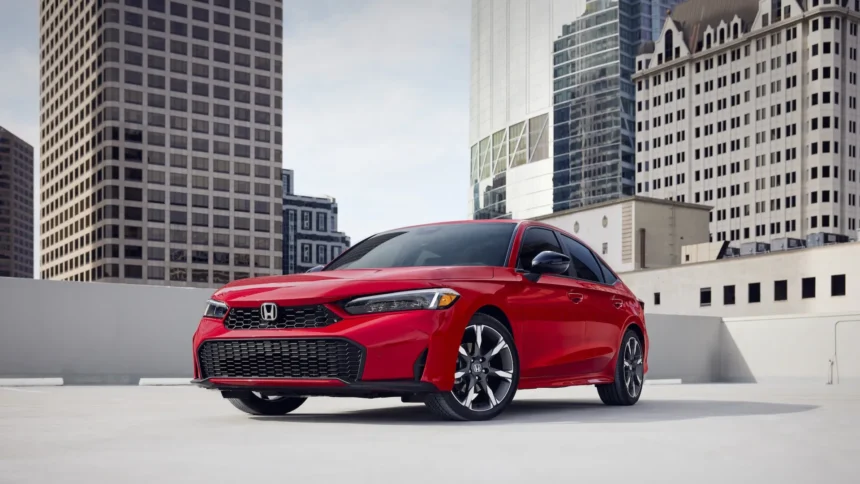The 2025 Hyundai Elantra and 2025 Honda Civic are two compact cars that offer a diverse range of options, from fuel-efficient hybrids to performance-oriented models. Both of these lineups are known for providing excellent value for money, stylish designs, cutting-edge technology, and luxurious cabin comforts that were once only found in more expensive vehicles.
While both lineups primarily consist of four-door sedans, the Civic is also available as a five-door hatchback, providing additional versatility for consumers. The Elantra N was a nominee for Best Car To Buy 2022, while the Civic Type R was the winner in 2023, showcasing the performance capabilities of both models.
In terms of pricing and features, the Elantra starts at $23,025, while the Civic starts around $25,000. The Elantra Hybrid begins at $26,000, with the more feature-rich Civic Hybrid starting at $30,000. The performance-oriented Civic Si costs $31,000, while the Elantra N tops $35,000, and the Civic Type R hatch reaches nearly $47,000.
When it comes to comparing the two models in terms of size, seating capacity, and cargo space, the Civic and Elantra are nearly identical in overall dimensions. However, the Elantra’s roofline and door cuts can make back seat access slightly tighter, although the real-world legroom feels more spacious in the Elantra. The Civic offers a hatchback option, providing easier access to the seats.
In the performance department, both the Civic and Elantra offer a range of powertrains to suit different needs. The Civic’s 1.5-liter turbo-4 engine delivers more power and better drivability, while the Elantra Hybrid prioritizes efficiency over performance. The Civic Hybrid pairs the turbo-4 engine with Honda’s 2-motor hybrid system to produce 200 hp and 232 lb-ft of torque, providing a seamless and powerful driving experience.
Overall, both the 2025 Hyundai Elantra and 2025 Honda Civic offer a compelling mix of features, performance, and value, making them standout choices in the compact car segment. Whether you prioritize fuel efficiency, performance, or luxury amenities, both models have something to offer for a wide range of consumers.
The Civic LX comes with a 7.0-inch touchscreen with wired Apple CarPlay and Android Auto, while the Sport trim adds a 9.0-inch touchscreen with wireless versions of the same. Touring models get a 10.2-inch digital gauge cluster, too.
The Elantra also stands out with its Digital Key system, which allows you to use your smartphone as a key for the car. This feature is not available on the Civic. Both models offer digital gauge clusters in their upper trims, providing a modern touch to the cockpit.
Overall, the Elantra offers larger touchscreens and more advanced connectivity features, giving it a slight edge in the interior tech department.
Advantage: Elantra.
Conclusion
In the battle between the Hyundai Elantra and the Honda Civic, both cars offer strong competition in the compact car segment. The Civic has a slight edge in terms of performance and driving experience, while the Elantra shines in fuel economy and interior tech features.
Ultimately, the choice between the two will come down to personal preferences and priorities. If you prioritize performance and handling, the Civic may be the better option for you. However, if fuel economy and advanced tech features are more important, the Elantra could be the ideal choice.
Both cars offer a compelling package in their respective segments, and either would be a solid choice for those in the market for a compact car. The decision ultimately comes down to what matters most to you as a driver. The Hyundai Elantra and Honda Civic are two popular compact sedans that offer a range of features to impress buyers. One area where the Elantra shines is in its tech-savvy features, including a phone-as-key system and over-the-air updates for infotainment maps and software. On the other hand, the Civic also holds its own with a base 7.0-inch touchscreen that supports both ecosystems with a cable, and a larger 9.0-inch touchscreen in higher trim levels.
In terms of safety, both the Civic and Elantra perform well in crash tests, with the Civic achieving top safety scores from both U.S. agencies and the Elantra coming close behind. The Civic offers standard safety features like adaptive cruise control, automatic high beams, and active lane control, while blind-spot monitoring is available on most models. The Elantra also comes equipped with automatic emergency braking and offers optional safety features like blind-spot monitors and adaptive cruise control. However, the Civic has better outward vision due to its design.
When it comes to warranty coverage, the Elantra has the upper hand with a 5-year/60,000-mile limited warranty on the vehicle, a 10-year/100,000-mile warranty on the powertrain, and 7-year/unlimited-mileage coverage on corrosion. The Civic, on the other hand, offers a 3-year/36,000-mile limited warranty on the vehicle, a 5-year/60,000-mile warranty on powertrain components, and a 5-year/unlimited-mileage warranty on corrosion.
Overall, the Honda Civic edges out the Hyundai Elantra in terms of performance, driving experience, and day-to-day livability, earning a higher TCC Rating of 6.8 compared to the Elantra’s 6.5. While the Elantra may appeal to those looking for hybrid mileage or a standout exterior design, the Civic remains a solid choice for those seeking a reliable and enjoyable compact sedan.
In conclusion, the Honda Civic emerges as the winner in this comparison, offering a well-rounded package of features, safety, and performance. Whether you prioritize tech innovations or warranty coverage, both the Elantra and Civic have something to offer for discerning buyers in the compact sedan segment. The Benefits of Yoga for Mental Health
Yoga has long been known for its physical benefits, such as increased flexibility, strength, and balance. But did you know that yoga also has numerous benefits for mental health? In fact, research has shown that practicing yoga regularly can help reduce stress, anxiety, and depression, as well as improve overall well-being.
One of the key ways in which yoga benefits mental health is by helping to calm the mind and promote relaxation. The deep breathing techniques used in yoga help to activate the body’s relaxation response, which can help reduce stress and anxiety levels. Additionally, the physical postures and movements in yoga can help release tension from the body, which can also have a calming effect on the mind.
Yoga has also been shown to improve mood and increase feelings of happiness and well-being. This is due in part to the release of endorphins, the body’s natural feel-good chemicals, that occurs during physical activity. Additionally, the focus on mindfulness and present-moment awareness in yoga can help individuals let go of negative thoughts and emotions, and instead focus on the present moment.
Another benefit of yoga for mental health is its ability to improve self-awareness and self-acceptance. Through the practice of yoga, individuals can develop a greater sense of connection to their bodies and minds, and learn to accept themselves just as they are. This can help reduce feelings of self-criticism and judgment, and instead foster a sense of self-compassion and acceptance.
Yoga can also be a powerful tool for managing symptoms of depression. Research has shown that yoga can help regulate the body’s stress response system, improve mood, and increase feelings of well-being in individuals with depression. Additionally, the mindfulness and self-awareness skills developed through yoga can help individuals recognize and manage negative thought patterns that contribute to depression.
Overall, the benefits of yoga for mental health are numerous and wide-ranging. Whether you are looking to reduce stress, anxiety, or depression, or simply improve your overall well-being, incorporating yoga into your routine can be a valuable practice. So next time you roll out your yoga mat, remember that you are not only benefiting your body, but also your mind.







